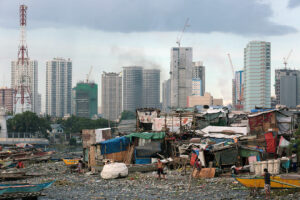




Philippines Trade Update: Trade trajectories trend along
 DOWNLOAD
DOWNLOAD

Policy Rate Updates: Double cut finale
 DOWNLOAD
DOWNLOAD

Monthly Economic Update: One for the road
 DOWNLOAD
DOWNLOAD


World Bank raises Philippine growth outlook

The Philippine economy is likely to grow by 6% this year amid strong domestic demand and despite elevated inflation, the World Bank said, raising its forecast from 5.4% in January.
A recovery in jobs, improved consumer sentiment and strong remittances from Filipinos overseas would drive local consumption, the multilateral lender said in its Global Economic Prospects report on Wednesday.
“Despite external challenges, high domestic inflation and tight monetary conditions, domestic demand has once again remained resilient, fueling growth,” World Bank Country Director for the Philippines Ndiame Diop separately told a virtual news briefing.
The latest growth forecast is the lower end of the government’s 6-7% growth target this year. The Philippine economy grew by 6.4% in the first quarter, slower than 8% a year ago and 7.1% a quarter earlier.
“Despite weak global conditions, our upward revision reflects this continued strength in domestic demand,” World Bank Philippines Senior Economist Ralph van Doorn said.
But the potential global slowdown could still affect growth. “Although the global economy displayed remarkable resilience in early 2023, economic conditions will remain subdued for the rest of 2023,” Mr. Diop said.
He said global growth is expected to wane due to “persistent inflation, slowdown of global trade and the effect of recent monetary tightening.”
The World Bank expects global growth to slow to 2.1% this year, though this is higher than its earlier 1.7% projection. It also sees global growth reaching 2.4% next year and 3% in 2025.
“Risks remain tilted to the downside,” Mr. Diop said. “Recent episodes of market instability have raised concerns of a potential spillover. The possibility of further monetary tightening amid sticky core inflation could raise the cost of global financing and lead to a more pronounced and prolonged global slowdown.” Persistent inflation remained a cause for concern, the World Bank said.
“Although our baseline forecast (shows) inflation will decelerate, it is still the main challenge,” Mr. van Doorn said.
The World Bank expects Philippine inflation to average 5.7% this year, higher than its earlier 4.2% forecast.
The Bangko Sentral ng Pilipinas (BSP) expects inflation to average 5.5% this year, above its 2-4% target.
Risks to inflation include logistical challenges, the threat of El Niño, geopolitical tensions and tighter financial conditions.
“While both core and headline inflation are expected to ease through 2023, in the near term, headline inflation is likely to remain above central bank targets in some countries (Mongolia, the Philippines) due to the delayed passthrough of increases in global commodity prices and domestic supply shock,” according to the World Bank report.
“In some cases, local food production disruptions and supply bottlenecks have added to price pressures, notably in Mongolia, Myanmar and the Philippines,” it added.
To curb inflation, the BSP has raised key rates by 425 basis points (bps) since May last year to 6.25%.
The World Bank expects Philippine inflation to slow to 3.6% in 2024 and 3% in 2025.
Mr. van Doorn said the fading of pent-up demand and softer investment growth could also dampen growth.
The Philippines should address inflationary pressures by using both monetary and nonmonetary tools and use revenue-enhancing policies to support growth.
“Improving public spending efficiency through better targeting of social protection measures is essential to protect the poor and vulnerable from economic shocks amid limited fiscal space,” Mr. van Doorn said.
Mr. Diop said the Philippines should also raise investments to “strengthen economic recovery, reduce vulnerability and achieve its long-term development goals.” — Luisa Maria Jacinta C. Jocson, Reporter
This article originally appeared on bworldonline.com





 By BusinessWorld
By BusinessWorld
